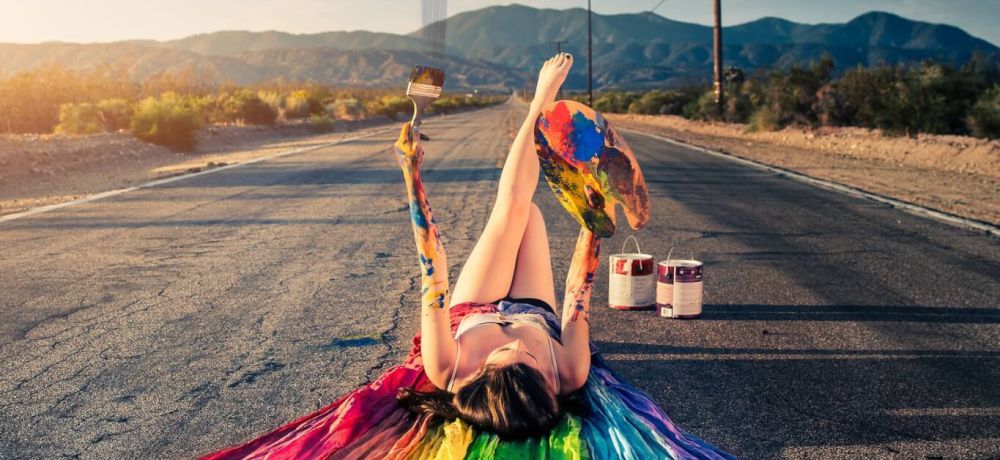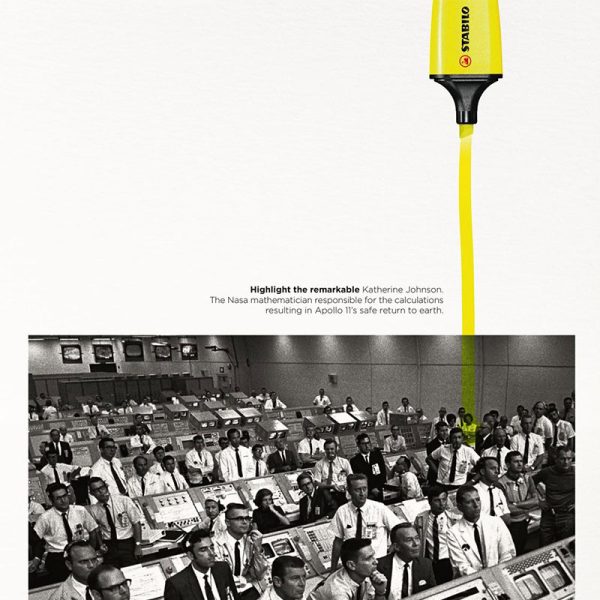
The effects of colors on behavior
Have a look at the advertisement below. What will you focus on first? Your gaze is most likely drawn to the highlighted woman. That’s the whole point of using a marker. The critical parts pop out. That’s one of the effects of colors on behavior: they attract attention. In this post, we are going to look at different perspectives on the effects of colors on behavior. Jumpstart 2022 and read what colors can do for you.

As described, colors can serve as a powerful visual cue to guide your attention. It is no surprise that companies highlight special offers or discounts with colors. And on a website, colors can contribute to increased usability.
An evolutionary perspective
Our brain is wired to pay attention to objects that are of a contrasting color compared to its surroundings. It helped our ancestors to find food, or to notice potential dangers and hazards. Also, in the animal and plant kingdom, bright colors serve certain survival functions such as reproduction and protection.
Colors are unarguably a valuable marketing tool. However, the question is: are some colors better for specific purposes? Let’s find out how you can leverage the effects of color on behavior.
An artist’s perspective
“Instead of trying to reproduce exactly what I see before me, I make more arbitrary use of color to express myself more forcefully.” — Vincent Van Gogh
Painters have discovered the power of color and studied what it does to the viewer for centuries. During the period of post-impressionism, in which artists focused on evoking emotions, colors were used for their underlying emotional associations.
Evoking emotions with colors
Movie producers also trigger mood and emotions with colors. In Pixar’s movie Inside Out color is a leading motif. Scenes in which the main character is happy are colorful. In grey and monotonous scenes, on the other hand, she is sad and without hope. In the movie, the five primary emotions have a distinctive color. Joy is of bright yellow, Anger of a warm red, Disgust of poisonous green, Fear of pale purple, and Sadness of deep blue. According to the director, they chose the color partly based on color idioms in the English language. For example: to feel blue/ have the blues (sadness) or to see red (anger).

Colors and their emotional associations are rooted in our cultural upbringing. They vary among cultures. In English, you are green with envy, in German yellow (gelb vor Neid sein). Purple is often associated with wealth, royalty and nobility. In Thailand and Brazil, purple is the color of mourning, however.
Also, within a culture, there can be differences, depending on the situation. Red can represent romance in a flower shop (red roses) or violence and unfairness during a football match (red card).
When choosing a color for your brand, the culture and context have to be kept in mind. Especially during a cross-cultural marketing campaign. This can be challenging. The effects of colors on behavior and emotions might be very different.
Cross-cultural similarities of warm and cool color associations
Some of the effects of colors appear across several cultures. Warm colors like red, yellow and orange evoke higher arousal emotions, such as love, passion, happiness, and anger. Cool colors, like blue, green and purple are linked to calmness, sadness and indifference.
Colors can trigger these arousal states and emotions. Several studies show the impact of the paint color used in offices or living rooms on the mood of people in them.
How color impacts our life
Colors in traffic
In many cultures, red means danger. Traffic signs that require immediate attention and reaction are usually red. That’s a good choice, the effects of color on behavior are applied.

From a neuroscientific perspective, making them red is a wise choice. In our brain, the majority of cells responsible for color vision are geared to respond to the color red. Therefore, red attracts our attention more. Hence, we can respond to a red cue faster.
Colors influence our taste
Did you know food color can increase our appetite and impact our taste? Orange is known to increase appetite and is often used for food packages and in fast-food restaurants. Blue triggers disgust and loss of appetite because there are no natural foods in (bright) blue. These implicit color expectations may alter how we respond to food or beverages.
For example, Nestle recently launched a Matcha Green Tea flavoured version of the KitKat chocolate bar in Europe. Green is not usually a color associated with chocolate, dessert and sweetness. Instead, if a (dairy) product turns green it indicates that it turned bad. Therefore, this color association might keep some Europeans from trying and enjoying this version of the chocolate bar.

Colors of clothes influence how we perceive people
The color of a person’s clothes influences which attributes and characteristics we link to her. It can be culturally biased through historic events or political groups, but that depends on the context.
Often, black is related to power, strength and authority. Think of black doctorate robes (intellectual power) or a black belt in karate (physical and mental strength). However, sports teams whose uniforms are black receive more penalties, and the players are associated with negative qualities such as aggression.
Color influences perception of temperature
Whether you are feeling warm or cold can depend on the color tone of your environment. In a room painted in warm color temperature will feel higher than the same temperature in a cool-colored room.
If you think of temperature-related associations to these colors, this is not surprising. Blue represents winter, ice, water, freshness, rain, wind, and your lips turn blue when you’re cold. Warm colors like red or yellow produce images like fire, sun, and summer in your mind. There are not called ‘warm’ and ‘cool’ colors for nothing.
Colors influence our decisions
The color of your product can be the reason for a customer to buy it. Colors excite emotions in people. The effects of color often go through emotions.
Our brain relies highly on emotions and feelings when making a decision (see Kahneman’s concept of System 1 and 2). Thus, it can come in handy to know which emotions your target audience associates with what color. As a result, you will be able to trigger precisely the feelings you want.
The use of warm colors in your campaigns or logo generally evokes trust and a positive attitude towards your brand. As a consequence, it leads to loyalty and increases purchasing intentions.
Your brand’s color also impacts your employees. One study found that red in the logo causes employees to work harder.
Colors influence our performance
Another study assessed the effect of colors on performance. Students who had to wait in a red painted room before taking an exam showed significantly lower test results. The researcher reasoned that it might be because red is associated with danger and failure (mistakes in exams are usually marked in red).
The same pattern of impaired performance caused by literally seeing red is present in sports games and competitions. In a study, teams that faced opponents wearing a red outfit lost more often than when the opponents were wearing blue.
Warm colors such as red and orange seem to activate the survival mode, increasing speed and force but decreasing patience and creativity.
Cool colors like blue seem to have opposing calming effects. They are relaxing and enhance creativity. Installing blue-colored lights in train stations or streets can even reduce the crime rate.
Colors influence the perception of time
Red initializes a survival reaction to cope with potential danger. The perception of time in those situations shifts. Remember a situation in which you were nervous and cautious; the time just felt endless. Evolutionary, this allows you to pay attention to greater detail and act more precisely in this moment of danger. Thus, our ancestors were aware enough to grab the spade to protect themselves from the tiger just in time. How could this be useful? It depends on the context. In a busy restaurant with limited seating, you might want customers to leave quicker. But at an airport you might want to let travelers perceive waiting times for delayed flights as shorter instead of longer.
Colors influence us physiologically
Color does not only affect our psychological and emotional state but also our body. Consistent with psychologically preparing for danger, red is known to heighten physiological alertness. It activates our nervous system and thus increases the heart rate and the amount of adrenaline circulating in our bloodstream. This fight-or-flight response enables us to react faster.
Also, the previously mentioned relaxing effect of cool colors like blue and green leads to physiological changes. They calm the body, and for example, reduce respiration and lower the blood pressure. Therefore, surgeons often dress in green or blue.
The effects of colors on behavior go even further. The color of a medical drug seems to have an impact on its effectiveness. Red, yellow and orange pills are associated with stimulating effects; blue, green and purple with relaxing, or even numbing effects.
A study investigated the impact of color on the placebo effect. All participants believed that they were given stimulating drugs, even though they all got placebos. One group got warm-colored pills, and the other group got cool-colored ones. The findings showed that the placebo effect was stronger in people receiving pills of warm colors than for those who received cool-colored ones.
What you should remember about colors
Get your marker and highlight this: colors, if chosen wisely, can have a significant impact. Color can affect how memorable something is, guide attention, evoke emotions, and even influence motor function and performance. Keep in mind that these effects can differ between cultures and contexts.
To get a better idea of how emotions link with the success of your marketing campaign, read our article about emotional marketing campaigns. Moreover, if you want to know more about guiding visual attention, you will find this article on visual cues very insightful.
A little food-for-thought to end with: color is not only associated with what we see. In our mind, certain tastes, scents and sounds are represented in specific colors. The more consistent you are, the stronger the emotional and physiological effects of color on behavior.
If you want to learn more about behavioral insights, read our blog or watch 100+ videos on our YouTube channel!
About Neurofied
Neurofied is a behavioral science company specialized in training, consulting, and change management. We help organizations drive evidence-based and human-centric change with insights and interventions from behavioral psychology and neuroscience. Consider us your behavioral business partner who helps you build behavioral change capabilities internally.
Since 2018, we have trained thousands of professionals and worked with over 100 management, HR, growth, and innovation teams of organizations such as Johnson & Johnson, KPMG, Deloitte, Novo Nordisk, ABN AMRO, and the Dutch government. We are also frequent speakers at universities and conferences.
Our mission is to democratize the value of behavioral science for teams and organizations. If you see any opportunities to collaborate, please contact us here.
